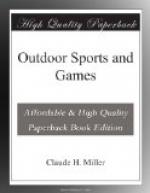While an expert can handle a sail eight or ten feet wide and twelve feet high it is better for the beginner to start with one much smaller. The construction of the sail and the method of holding it are shown in the diagram.
[Illustration: A skate sail]
Snowshoeing is another winter sport that will furnish a great deal of pleasure and will enable us to be outdoors when our less fortunate friends may be cooped up in the house. There are a number of standard shapes in snowshoes, but probably the “Canadian” model will be found to be the most satisfactory generally. Snowshoes should be from twenty-four to forty-four inches long depending on the weight to be carried. In order to enjoy snowshoeing we must use moccasins. The proper method of attaching the snowshoes is clearly shown in the diagrams. The beginner will find that snowshoeing is a very simple art to acquire, being far less difficult than skating and with far less danger of having a bad fall.
[Illustration: Four types of snowshoes]
The sport of “ski-running” or skiing is practised more generally abroad than in this country. A number of winter resorts owe their popularity largely to this sport. Skis are simply long flat pieces of wood fastened or strapped to the shoes. The best type are the so called “Norway” pattern. Various lengths are used from four to eight or nine feet long, but for a beginner the shorter ones will be better.
[Illustration: To throw the lumberman’s hitch, start this way]
[Illustration: Then across the toe with both ends and under the loop]
Ski-running is simply coasting down steep inclines on the snow with the skis used in much the same way as a sled. The longer they are the greater the speed obtained, but the longer ones are also correspondingly hard to manage.
[Illustration: Draw the ends tightly forward to fasten down the toe]
[Illustration: Then tie the ends together in a bow knot back of the heel]
In Norway and Sweden skis are made to order just as we might be measured for suits of clothes. The theory is that the proper length of ski will be such that the user, can, when standing erect and reaching above his head, just crook his forefinger over it as it stands upright. Ski shoes should be strong, with well blocked toes. A pair of heavy school shoes are just the thing if well made.
[Illustration: The straps over the toe remain buckled]
[Illustration: This is the “thong” hitch but it is not as good as the lumberman’s hitch]
To learn skiing we should select the slope of a hill not very steep and with no dangerous rocks or snags to run foul of. The best snow conditions are usually found two or three days after it has fallen. Fresh snow is too light to offer good skiing and snow with a crust is also bad. In running with skis on the level ground a long, sweeping stride is used somewhat after the fashion of skating. The strokes should be made just as long as possible, and the skis kept close together. In going up an incline the tendency to slip backward is overcome by raising the toe of the ski slightly and bringing the heel down sharply. One foot should be firmly implanted before the other is moved. In going up a steep hill a zigzag course will be necessary.




